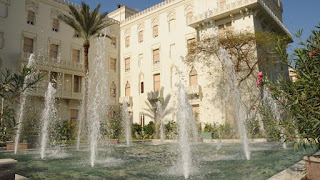Al-Ittihadiya Palace (Heliopolis Palace)
Al-Ittihadiya Palace, otherwise called Al-Oruba Palace or Heliopolis Palace, is situated in Heliopolis, Cairo. It is the authority work environment of the Egyptian Presidency where the president gets official visiting assignments. The royal residence is situated in the uptown region, Heliopolis (Masr El Giada), East Cairo.
Heliopolis Palace was first opened by the French organization that debuted the main extravagant inns in Africa on December 1, 1910. The castle was deserted after the Nationalization age. Afterward, during the 1960s, it was the seat of a few government organizations and services. In January 1972 during Sadat's administration of Egypt, the castle turned into the central command for the Federation of Arab Republics that included, around then, Egypt, Syria and Libya. From that point forward, the castle came to be known as "Al-Ittihadiya Palace" or "Royal residence of Al-Oruba".
Royal residence rooms were extravagantly outfitted after the style of Louis XIV and Louis XV. The fundamental center corridor highlights great oriental precious stone crystal fixtures.
The arch of the Palace is 55 meters strategic position to roof. Principle lobby is 859 square meters, planned by Alexandre Marcel and beautified by George Louis Claude. The castle is additionally ornamented with stunning oriental covers and beautified with floor-to-roof mirrors accepting a gigantic chimney made of marble. There are additionally 22 tremendous Italian segments made of marble. At the opposite finish of the fundamental center corridor, there is a huge lounge area involving 150 seats and another room including 3 billiard tables, two of which were huge of Thurston style.
The London-mahogany furniture and the upper workplaces oak wood of famous Paris Kroger brags of pomposity.
The royal residence was deserted after the Nationalization age. Afterward, during the 1960s, it was the seat of a few government organizations and services. In January 1972 during Sadat's administration of Egypt, the royal residence turned into the central command for the Federation of Arab Republics that included, around then, Egypt, Syria and Libya. From that point forward, the castle came to be known as "Al-Ittihadiya Palace" or "Royal residence of Al-Orouba".
A significant upgrade of the royal residence was started during the 1980s to save its legacy. It features gigantic precious stone light fixtures, 22 segments in the fundamental center 600 m2 corridor. One of the sides includes an enormous lounge area. The royal residence arch, reaches out to 55 meters in stature. A rail route is implicit the storm cellar along the structure's organization office, kitchens, stores and staff workplaces. Late Egyptian President Hosni Mubarak didn't live in the castle besides during true working hours. He resided in his own home in Heliopolis suburb.







NICE
ReplyDeletegood information thanks a lot
ReplyDelete